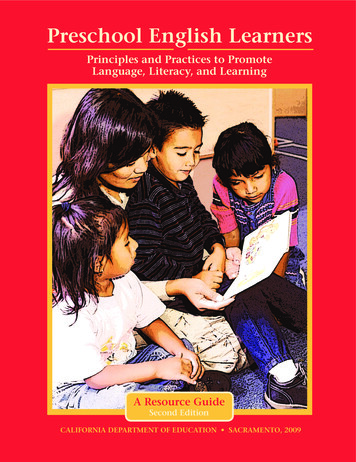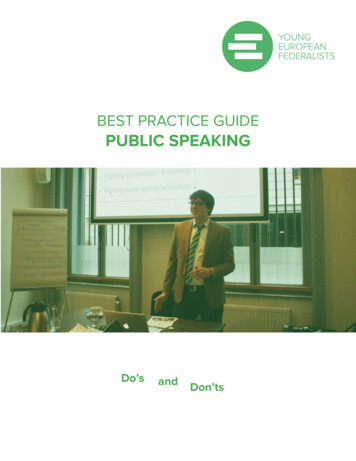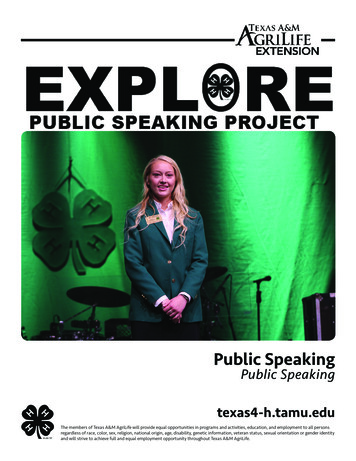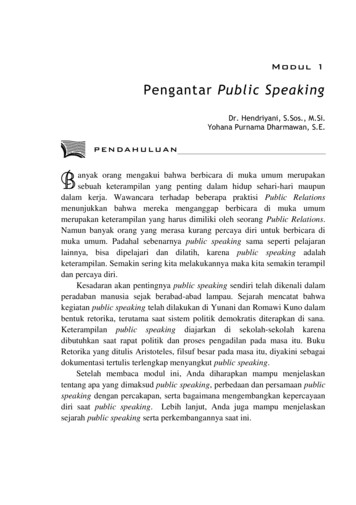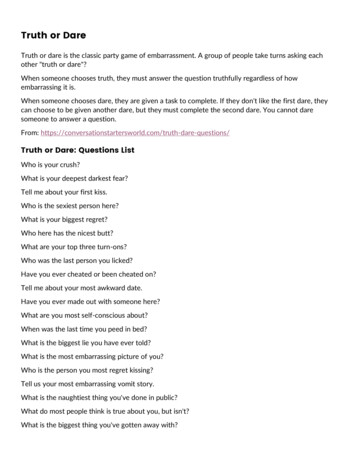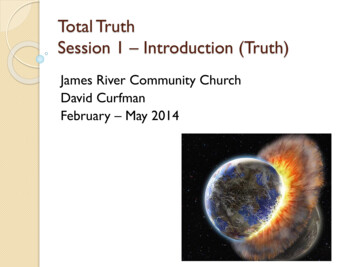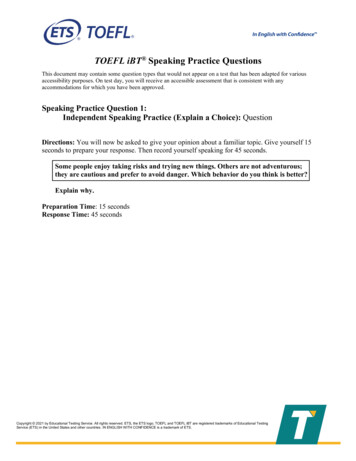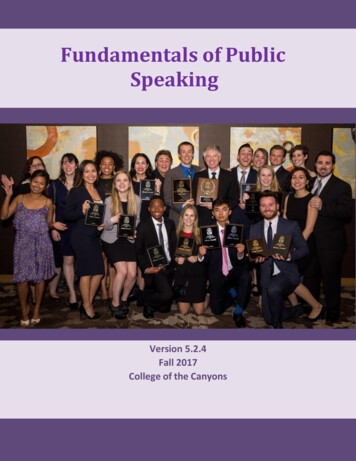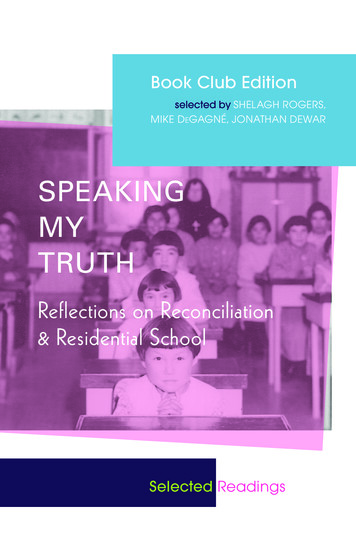
Transcription
Book Club Editionselected by SHELAGH ROGERS,MIKE D EGAGNÉ, JONATHAN DEWARSPEAKINGMYTRUTHReflections on Reconciliation& Residential SchoolSelected Readings
“SPEAKINGMYTRUTH”Reflections on Reconciliation& Residential SchoolSelected byShelagh RogersMike DeGagnéJonathan DewarAboriginal Healing Foundation 2012
2012 Aboriginal Healing FoundationPublished by: Aboriginal Healing Foundation75 Albert Street, Suite 801, Ottawa, Ontario K1P 5E7phone: (613) 237- 4441 / toll-free: (888) 725 - 8886fax: (613) 237- 4 442 / email: research@ahf.cawebsite: www.ahf.caDesign & Production: Glen Lowry, Anja BraunPrinted by: Hemlock Printers, Burnaby, BCPrinted version: ISBN 978-0-9876900-4-3Electronic version: ISBN 978-0-9876900-5-0“Speaking My Truth”: Reflections on Reconciliation & Residential Schoolis the full title of this edited volume. It comprises selections from theAboriginal Healing Foundation’s Truth and Reconciliation Series: Vol. 1 FromTruth to Reconciliation; Vol 2. Response, Responsibility, and Renewal; andVol 3. Cultivating Canada.Unauthorized use of the name “Aboriginal Healing Foundation“ and ofthe Foundation’s logo is prohibited. Non-commercial reproduction of thisdocument is, however, encouraged.This project is supported in part by the Advocacy and Public InformationProgram at Aboriginal Affairs and Northern Development Canada— Ce projet est appuyé en partie dans le cadre du Programme d’informationpublique et de défense des intérêts des Affaires autochtones et Développement du Nord CanadaThis project was funded by the Aboriginal Healing Foundation (AHF), but theviews expressed in this reader are the personal views of the author(s).Ce document est aussi disponible en français.
Contents5Shelagh Rogers A ForewordFrom Truth to Reconciliation9Garnet Angeconeb Speaking My Truth: The Journey toReconciliation35John Amagoalik Reconciliation or Conciliation? An InuitPerspective47Madeleine Dion Stout A Survivor Reflects on Resilience53Fred Kelly Confession of a Born Again Pagan (excerpt)75David MacDonald A Call to the Churches: “You shall be calledthe repairer of the breach”103David Joanasie Perspective on Reconciliation from an Inuk YouthResponse, Responsibility, and Renewal109Jose Amaujaq Kusugak On the Side of the Angels129Rita Flamand Truth about Residential Schools and Reconcilingthis History: A Michif View145Drew Hayden Taylor Cry Me a River, White Boy157Richard Wagamese Returning to Harmony
Cultivating Canada169Mitch Miyagawa A Sorry State193Sid Chow Tan Aiyah!1 A Little Rouse of Time and Space (excerpt)205Roy Miki By Turns Poetic: Redress as Transformation (excerpt)223Cheryil L’Hirondelle, Joseph Naytowhow, b.h. Yael Land Project: AConversation between Canada and Israel/Palestine251Questions for Reading and Discussion
Shelagh RogersA ForewordFormed under the tutelage of the Bishop of Orléans, FélixAntoine-Philibert Dupanloup, painter Paul Gauguin returnedlate in his life to the catechism and its concern with the firstprinciples. His 1897 masterpiece Where Do We Come From?What Are We? Where Are We Going? represents both the beginning and endpoint of the painter’s personal and artistic journey.Similarly, the collection before you issues from these elementalquestions, establishing a variegated canvas whose thematicunity derives from a shared desire to renew Canada.How did we get to where we are now? Until we understand that,our future together as Indigenous and non-Indigenous peopleslooks uncertain at best. This project is animated by a hope thatdebate—in the spirit of the catechesis itself—will take place inbook clubs across the country, composed of people who like discussion and are energized, engaged, and jazzed by the journeyof rebuilding, reconciliation, and renewal.There is hope that more of us will arrive at an understanding ofour history, acknowledging the cold colonial spring from whichCanada has come; that more of us will be moved to action; thatthrough this volume we will further our self-knowledge and5Shelagh Rogers
our empathy. History is the account we present to ourselves ofour collective journey. This account, if it is to be faithful andcompassionate, must include the first-hand accounts of residential school experiences—of those separated from their families,from their communities, and from relationships with otherCanadians. Colonialism is a disruption and supplanting of theelemental. It takes what is not one’s to take and gives what isnot one’s to give. It presumes the very questions: “Where Do WeCome From? What Are We? Where Are We Going?” silencingthe Indigenous voices and dinning the ears with its script.This collection of essays returns us to the proper work of dialogue, answering some questions but inevitably, and necessarily,provoking more. I hope it will prod us to get off our big fatcomplacencies. We must investigate our own histories, askingquestions about the land on which we work and live. What isthe history of this land? Who was here before us? How did wecome to occupy and define it? What was my family’s relationship to Indigenous peoples?I’ve been looking at my own genealogy, and my family is complicit in this work of colonialism. My ancestors came from theOrkney Islands, bringing with them the imperialism of Europe.They worked for the Hudson Bay Company and thought thatthe land was ripe for the taking. My 4x-great-grandfather wasSir George Simpson. Having learned more about him, I nowbetter understand the relationship between Indigenous peoplesand the colonizers. This relationship is saddening, and it’stroubling. It was an unequal relationship, to say the very least.6Shelagh Rogers
People like Sir George were credited with “opening up” thecountry. People like Sir George would not have even survivedhad it not been for the help and guidance of Indigenous peoples.It must be asked: Why do we not read about this in schooltextbooks? Why have we not yet learned the true history ofCanada?The experience of reading these pieces will be engaging. Thevariety in this collection represents the full range of emotions,from sorrow to joy, and not without humour. Don’t be afraidof what you will feel as you read. Allow yourself to feel uncomfortable. You may feel shame if your relatives were colonizers. I,too, have felt this shame. I had to witness before more than onethousand people, at the Northern Gathering of the Truth andReconciliation Commission of Canada. The day set aside for meto talk about what I’d seen, heard, and learned was July 1st—Canada Day. I felt so ashamed of my country. But an Ojibwayelder told me that this feeling was the beginning of real learning,as rational understanding makes way for the heart to take it in.The real shame, he said, would be to feel no shame.The longest journey is from the head to the heart. Let usopen our hearts so that we may help carry the pain thatIndigenous peoples in Canada have been carrying for centuries. Non-Aboriginal people will not be fully at home hereas Canadians until we acknowledge the troubled genesis ofCanada, its colonial past and present. When that is recognized and accepted, we will have a chance to live on this landwith some feeling of wholeness.7Shelagh Rogers
Colonialism is not over. Its tentacles reach into the present, andit is the greatest stain on Canada. Colonialism has put a wallup between Aboriginal and non-Aboriginal peoples in Canada.The journey from truth (hearing the stories) to reconciliation(fixing what is broken and building and re-building) will involvetaking apart a whole system of colonialism and entrenched relationships—personal, political, and philosophical. It isn’t goingto be easy, but it’s our only chance. And the very soul of Canadais at stake.In short, let’s talk to each other. And let’s really listen. Thisbook is a great beginning.8Shelagh Rogers
Garnet AngeconebSpeaking My Truth:The Journey toReconciliationWhen I walked into the Aboriginal Healing Foundation officein Ottawa in December 2007 to interview Garnet Angeconeb,I was unsure what to expect. I knew that Garnet was a residential school Survivor, a member of the Aboriginal HealingFoundation’s board of directors, and a journalist. What I didn’tknow was what a warm, compassionate, and fascinating person he is. For the next two days Garnet and I talked abouthis life, and I felt privileged to sit with him and hear aboutthe challenging experiences he’d survived and overcome. As Ilistened, I was struck by how open, honest, and generous hewas in sharing his story. It was inspiring. Deeply rooted in hisAnishinaabe culture and community, Garnet is an unassuming,soft-spoken, spiritual man who is passionate in his quiet andhumble way. He has a vision for the future of residential schoolSurvivors and their families and communities that he is determined to help make a reality. Garnet stressed again and againthat his story is just one of many—that every residential schoolSurvivor has a story to tell. In telling his story he made it clearthat he hopes it helps others to find their voices and tell theirown stories. It was an honour to work with him to bring hisstory to you. — Kateri Akiwenzie-Damm9Garnet Angeconeb
At Home on Lake Seul: The Early YearsAs a young child, I lived with my mother Mary, my father David,and my brothers and sister on the trapline in the Lac Seul areaof northern Ontario. It was a happy time in my life. Then in1959, when I was four years old, my older brother Harry wastaken to the Pelican Indian Residential School located abouttwenty miles from our home. He was six years old. This was thefirst of many changes to occur over the next few years.The winter of 1961 began early, and by late fall ice wasalready forming on the countless bays of Lac Seul. On thetrapline, every minute of daylight is important. Motherand Father would rise in the wee dark hours of morningto begin their daily chores. In the evenings, I would fallasleep listening to Mother and Father talk about their dayor Mother recount a story or legend. One particular night,a long turn of events began that lasted all winter. I awoke inthe middle of the night and found that Mother and Fatherwere up. My baby sister Florence and my little brotherRonald were both in deep sleep, but I sensed there wassomething wrong by the sound of my parents’ voices.“Your father is very ill,” Mother said to me. Sitting up, I couldsee Father sipping tea by the wood stove, visibly uncomfortableand shaking from his illness. When I awoke again, daylighthad already broken. Mother and Father were busy doing theirdaily tasks, only this time they seemed to be doing more thanusual. Mother was packing all our worldly possessions—blankets, dishes, food, clothing, and furs. We were going back to10Garnet Angeconeb
the village of Ningewance Bay to be near help should Father’scondition worsen. At least there we would be close to my grandparents, Rupert and Christina Ningewance, and their large extended families. Normally, we would have stayed on the traplineuntil Christmas, but not that year.While Mother was busy packing, Father was working down bythe shoreline in his putt-putt. “Putt-putt” was the nicknamefor a type of wooden boat used by the Lac Seul Anishinaabekfor their commercial fishing activities in the 1960s. To keep theyounger children warm, Father put a canvas shelter over theputt-putt, and inside he set up a little wood stove. The journeythrough the frozen waters of Bray Bay, where our cabin waslocated, to Lac Seul was slow because Father had to use an axeand an ice-chisel to break the ice in front of the boat.At Ningewance Bay, it became clear how seriously ill my fatherwas; he went to bed and there he stayed until the warm windsof spring arrived. Extended family members and others wouldhelp us a great deal that winter. We were so grateful wheneversomeone arrived with a fresh catch of fish or moose meat tofeed our hungry stomachs. There were many nights we wentto bed hungry and tired. Help from others was always verymuch appreciated.Throughout that winter, I watched my father fade into a deepunknown illness. I was often scared. I had involuntarily becomethe man of the house and had to assume a lot of responsibility. Igot firewood, hauled water from the waterhole down at the lake,11Garnet Angeconeb
and went for help at times when my father’s condition worsened.Many nights Mother would rouse me from bed to seek helpfrom neighbours and relatives. I would walk through the bushin the middle of a winter’s night to tell people that Father wasvery sick and that he might die very soon. Walking along thebush trails of Keesic Bay Island with my coal oil lantern was aneerie experience. I was so scared that I never turned my headin case someone was lurking behind me. Now I realize it wasprobably the spirits looking after me, and certainly the GreatSpirit was always watching over me. The walk home was such arelief because someone always came back with me to sit besidemy ailing father.It was a long and difficult winter for me and my family. Finally,the snow and ice began to melt. The days were getting longer.In the air there was the welcomed call of the crow—an-deg.The return of the an-deg was a sure sign of spring. Fathersought help from two highly regarded Elders from the community: Ochi-kiyashk (Baby Seagull), otherwise known as TomPemmican, and Baswewe (Echo), otherwise known as JeanSouthwind. I recall Father attending healing ceremonies withthe Elders. He would faithfully take the medicines they gave tohim and soon he began to feel better. Through this experience,I learned the importance of respecting Elders to the highest degree. And not only that, but to have respect for everyone. This isa lesson I still struggle with each day.In the Anishinaabe tradition, one brings gifts and an offering ofsacred tobacco to the Elders when seeking their advice. Mother12Garnet Angeconeb
and Father would gather whatever they had to take as gifts tothe Elders—hunting rifles, ammunition, traps, knives, tools, orclothing. Father taught us to give things of value to others: theteaching of sharing. I also learned the importance and significance of offering tobacco. These were teachings that would helpme throughout my life.Separation: The Residential School YearsShortly after my dad was well again, I was forced to go to thePelican Indian Residential School where Harry was already astudent. I attended the residential school and lived in the schooldormitories until 1969. My older brother was there until 1968.My sister Florence was forced to go in 1968, and eventually myyounger brothers Ronald and Gordon followed. Although I sawmy brothers, I had no contact with my little sister because boysand girls were kept separate.My father had attended this same residential school as a littleboy. He was the ninth student enrolled when the school openedin 1927. He attended for five years. When he spoke about it, hetalked only about working on the farm. The “students” wereactually unpaid farm labourers—there was very little classroomteaching or instruction of any kind except, perhaps, for whatever religious teaching the children received when forced toattend chapel.When I attended the Pelican Indian Residential School inthe mid-1960s there were about two hundred and fifty of us13Garnet Angeconeb
students ranging in age from six to twelve. For six years I attended school there and lived in the dormitories. The SeniorBoys Dormitory Supervisor was Leonard Hands, a young manin his early twenties. Hands came to the school from Torontothrough the Anglican Church. He was not a teacher or socialworker and had no qualifications for the job of dormitorysupervisor. Regardless, he was given responsibility for the seniordorm that housed about forty of us boys aged ten to twelve.Hands had private quarters near the dormitory. In the morningand evening he supervised us. In the morning he made sure wegot up on time, ate breakfast, did our morning chores, and attended chapel before going to the school. After school, he wouldmake sure we did chores, had supper, attended evening chapel,and went to sleep when we were supposed to do so.Forgetting: The Lost YearsWhen I left the school in 1969 at the age of twelve, I buried thememories and feelings of my time there and rarely spoke aboutthem again until many years later. I began drinking to dull thepain and anger I felt. It was a coping method I used for a longtime. I struggled with a sense of spiritual confusion and tryingto figure out my place in the world.One wickedly cold January night when I was twenty years old, Isat in a local bar wasting my paycheque on booze for me and mydrinking buddies. A bunch of former residential school studentssat at my table guzzling bottle after bottle of beer. One beer wasnot enough it seemed, yet one beer was too many for most of us.14Garnet Angeconeb
An old school chum, Paul, screamed across the barroom, “HeyGarnet! Remember that asshole supervisor at Pelican? Youknow, that guy we used to call Beanie!”“Yep! I remember that asshole! He didn’t have the last nameHands for nothing. Why don’t you forget about that useless pieceof shit. If I ever see that bastard, I’ll kill him!” I yelled back.Once in awhile, usually while in a drunken stupor, former students would muster enough courage to talk about our negativeexperiences at residential school. As much as people wantedsuch conversations to carry on, these exchanges were alwaysquick to end. The memories of Pelican were best forgotten andwashed away by beer I thought—at least it felt like some of thepain was numbed by the alcohol.“Paul, I’ve got to go,” I yelled over the noisy jukebox that wasblasting Heaven’s Just a Sin Away. “I’m heading for Keesic Bayto visit my folks tonight.”I jumped on the snowmobile I had borrowed from mybrother. Although I was in no shape to go, I set off at topspeed into the cold winter night for Keesic Bay on the LacSeul First Nation traditional territory where my parents lived.When I was about eight miles from home, I somehow gotthe snowmobile bogged down in the heavy snow around theshoreline. Try as I might, I couldn’t get it out. Being a youngman of twenty years, I foolishly decided to walk the rest ofthe eight miles. It was pitch black and the coldest night of15Garnet Angeconeb
the winter. Before long, I realized that I had strayed from thesnowmobile trail. I was lost.I had no matches to start a fire. It seemed senseless to bed downin the bush, and so I pushed on, walking out into the vast openair in the middle of the frozen lake. I quickly lost all sense ofdirection. I could see nothing except darkness and the snowblowing all around me. I was in the middle of a fierce blizzard,the kind of storm my father had warned me about. Each stepbecame a real challenge as I walked aimlessly in circles in thedeep slush. My boots were getting heavier as ice began to formfrom my knees down.I realized that I was in big trouble. I couldn’t even put myfate into the hands of the Creator. As a young person whowent through the residential school system, I was deeplyconfused about my spirituality. I refused to believe in JesusChrist. And now, as I lay on the frozen lake of Lac Seul, buried in the snow, I questioned how I could rely on God’s helpwith whom I didn’t have a relationship. Somehow, though, Ilearned to pray again that night.After lying down half-buried in snow for what seemed likeinfinity, I heard the familiar sound of a snowmobile off in thedistance. I looked up. The blizzard had subsided. In the dark,I could see the faint outline of the landscape and the distantflicker of two snowmobile headlights. I yelled at the top of mylungs but I was too far away. Later I learned that my father anduncle had been out looking for me.16Garnet Angeconeb
I buried myself in snow to stay as warm as I could. I would yellevery once in a while into the stillness of the night. It seemed tohelp with blood circulation, and I would feel warmer for a littlewhile. It was a long night, probably the longest night of my life.Then, as I looked into the night sky, I saw a woman approachingme. She looked like my mother but it was as if she was the spiritof Mother—a holy, spiritual being. In the Anishinaabe language,the woman assured me that I was going to be all right. As shewas talking to me, I noticed she was carrying a large blanketmade of rabbit skins. In the sweetest voice I had ever heard, shesaid, “Here, I have come to cover you with this blanket so youdon’t get cold out here. This blanket will keep you warm.”I dozed off. By this time, I felt so warm under the cover of a loving Mother’s rabbit quilt. When I awoke sometime later, I couldsee the early hints of the morning sunrays. It was the first day ofFebruary, my only sister’s birthday. The sunrise was beautiful.The skies were beginning to glow pink and orange. I couldn’tbelieve that I had survived that long, cold night.I looked around me. Tobacco was sprinkled all around where I hadbedded down. I unburied myself from the snow and sawed awaythe huge chunks of ice around my legs and feet. I stood up butquickly fell back down. I thought, now that daylight had arrivedsomeone would soon find me. I laid down quietly to wait for help.Help soon arrived in the form of an OPP airplane. Aftercircling a couple of times, the airplane landed and stoppednear me. Right away I recognized the two police officers who17Garnet Angeconeb
disembarked. Constable Roydon Kropp was the first officer tojump out of the airplane. He was followed by Constable MylesLang. I was unable to walk so the two officers dragged me tothe airplane. The pilot, Sergeant Larry Moore, remained onboard and helped to lift me into the warm aircraft. After landing, I was taken by ambulance to the Zone Hospital in SiouxLookout where I was laid up for three months. I had sufferedsevere frostbite to both feet and legs. Not only had I miraculously survived an entire night in 40 below weather, I had alsoescaped the real threat of amputation.When I think back on it now, I see the vision of the woman whocovered me in the rabbit fur quilt as a symbol of hope. With herloving presence, against all odds, I survived. I now know therewas a reason I survived, but it took me a number of years tounderstand what it was.Remembering: The Grieving YearsUnderstanding first began to develop on October 31st, 1990when I was set on a path that I continue on to this day. I wason a business trip in Ottawa. That morning, I got up, showered,dressed, and headed downstairs to meet a colleague for breakfast in the Toulouse restaurant. He was already sipping his thirdcup of coffee by the time I got to the breakfast table.“Hey look at this front-page article on the residential schoolissue,” he said as he sipped his coffee.18Garnet Angeconeb
I had my own copy of the Globe and Mail tucked under myarm. There, on the front page, was an article about how thethen-Grand Chief of the Assembly of Manitoba Chiefs, PhilFontaine, had publicly disclosed that he had been physically andsexually abused while attending an “Indian” residential school.As I read the article, I began to feel an indescribable pain crawling all over my body. With great difficulty I struggled to maintain my composure. I looked over to my colleague and, withoutthinking, asked him if he’d ever been abused while living in oneof the notorious “Indian” residential schools.His immediate response was “No.” I guess I was hoping thathe would say he had been. In some way I wanted him to sayyes, so that we would have something in common to talk about:a legacy of abuse from the residential school system that hadhaunted me ever since I left the school in 1969.I felt incredible pain build up inside me. Through this haze ofpain, I struggled to admit to my colleague that I, too, like manyformer students, had experienced sexual and physical abusewhile at residential school. I was also enraged by the psychological and spiritual scars inflicted on me and the other studentsfrom the colonialistic and genocidal approach inherent in theresidential school system. My colleague and I grew almost completely silent. The silence continued as we ate our breakfast.After a while my colleague quietly asked, “So you wereabused in residential school?”19Garnet Angeconeb
Not knowing what exactly to say, I responded, “Yes, I wasabused—sexually.” I told him that a man at the school namedHands, who eventually became an Anglican priest, had abusedme and many others at Pelican during the 1960s. I felt a waveof rage overtake me. I had a huge lump in my throat as Istruggled to hold back the pain that I had buried for so manyyears. Then, as if a floodgate had been thrown open, I crieduncontrollably. It was the first time I had ever told anyone thatas a little boy I had been sexually abused at residential school.For the next year I tried to figure out how to deal with thatadmission. I had to tell my family (I have been married since1978 and had never spoken of the abuse to my wife). It tooka lot of soul-searching—I had so many doubts. It was a veryemotional time. I experienced a lot of anger and grief. My children were ten and eight years old, and I had to explain to themwhat was happening because my behaviour during that timewas unsettling for them. I was drinking a lot and crying often.I had to come to terms with the idea of others knowing whathad happened to me. I sought help from a mental health nursewho helped prepare me to meet with Leonard Hands, the manwho had abused me. She made me feel validated and helpedme to realize that although I’d had no control over the abuse, Idid have control over the process of disclosure.Disclosing: The Truth-Telling YearsIn late 1991, I was ready. I met with Bishop James Allen of theAnglican Keewatin Diocese to disclose my abuse. The bishop20Garnet Angeconeb
said he would come back and deal with it after Christmas. Heleft soon after and never did deal with it. It was very discouraging, but a new bishop, named Tom Collings, was appointedto the diocese in the new year. After discussions about anout-of-court process, Bishop Collings suggested that I meetwith Leonard Hands to discuss it. I agreed. The day before mymeeting with Hands, I went to the site where the abuse hadtaken place at Pelican Falls. Once there, I prayed for courageand strength to get me through this ugly ordeal. As I left thegrounds, I spotted a bald eagle soaring way up in the clearblue sky. I took that as a sign of hope for restoration, for healing, for reconciliation, and for forgiveness.It was April 1992 when I met face-to-face with Leonard Hands,the person who had abused me in residential school. There wasstrong denial from him, and the meeting ended with no resolution. Still, I realized later that confronting him was a significantmilestone on my long journey toward healing.As I pursued the matter, the first hurdle I had to overcome wasdenial from those around me. My parents didn’t directly tellme, but did tell my siblings that perhaps I should drop whatI was doing and move on with my life. Many leaders also didnot support me. An Elder told me that it was because so manyof them were in denial themselves. Perhaps it was too painful.During this time I often wondered, “Is anyone out therereally listening?” It saddened, frustrated, and angered me.Then I started to link up with others who were also dealing21Garnet Angeconeb
with residential school abuse. In northwestern Ontario,there was a heavy layer of silence surrounding the issue.Some people even questioned my motives for pursuing mycase, suggesting that I was doing it for political gain. But asI learned about others who were taking action and began toconnect with them, I began to feel supported. It gave me thestrength to continue.Still, it was very difficult. The denial and silence extended tothe churches as well as the government. It took more thanthree years for Michael Peers, then-Primate of the AnglicanChurch, to respond to a letter from me, and when he did it wasin a very legalistic way. Obviously, the letter was written bylawyers since the Church must have feared law suits. One ofthe things that I’ve learned, whether dealing with governmentor churches, is that we’re afraid of each other. We’re afraid totalk openly to each other.Despite this, I continued to pursue my case. My mother neversaw the end of what I started. Sadly, she died in April 1993.Later that year, in September, the OPP began investigatingmy allegations of sexual abuse. At first I was all alone in theallegations. By the time it was over, there were nineteen of uswho had given statements about having been sexually abusedby Leonard Hands. The police believed there were a lot more,and I knew myself that there were others who weren’t willingto come forward. Around the same time, in 1993, there wereallegations that Hands was abusing an altar boy at his parishin Kingston, Ontario. Hands was suspended by the Church,22Garnet Angeconeb
although no charges were laid. It was sickening to me to realize that he was still abusing boys, and I wondered how manyothers there had been in the years between.When the police investigation of my case started, my fathersaid that maybe I should drop it and move on with my life.It wasn’t until after my father realized that two of his othersons (this meant three of his six children) were also abusedby the same man that he started to change his views andbecame more supportive. Father also began to recognize andunderstand the patterns of behaviour of his sons—the anger,drinking, short tempers, and so on—that we’d been using tocope with our abuse as well as with the shame and secrecythat had surrounded it.The sign that my father was really supportive was when he wentto court on the day that Leonard Hands was being sentenced.Hands was convicted on nineteen counts of indecent assault,and my father was there in the courtroom. He realized thatday that there were sixteen other men who had been abused inaddition to my brothers and me.
"Speaking My Truth": Reflections on Reconciliation & Residential School is the full title of this edited volume. It comprises selections from the Aboriginal Healing Foundation's Truth and Reconciliation Series: Vol. 1 From Truth to Reconciliation; Vol 2. Response, Responsibility, and Renewal; and Vol 3. Cultivating Canada.
